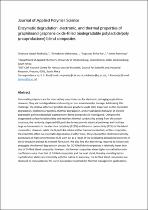 ResearchSpace
ResearchSpace
Enzymatic degradation, electronic, and thermal properties of graphite and graphene oxide-filled biodegradable polylactide/poly (å-caprolactone) blend composites
JavaScript is disabled for your browser. Some features of this site may not work without it.
- ResearchSpace
- →
- Research Publications/Outputs
- →
- Journal Articles
- →
- View Item
| dc.contributor.author |
Botlhoko, Orebotse J

|
|
| dc.contributor.author |
Makwakwa, Dimakatso M

|
|
| dc.contributor.author |
Ray, SS

|
|
| dc.contributor.author |
Ramontja, J

|
|
| dc.date.accessioned | 2019-04-12T08:51:37Z | |
| dc.date.available | 2019-04-12T08:51:37Z | |
| dc.date.issued | 2018-12 | |
| dc.identifier.citation | Botlhoko, O.J., Makwakwa, D.M., Ray, S.S., and Ramontja, J. 2018. Enzymatic degradation, electronic, and thermal properties of graphite and graphene oxide-filled biodegradable polylactide/poly (å-caprolactone) blend composites. Journal of Applied Polymer Science. doi.org/10.1002/app.47387. | en_US |
| dc.identifier.issn | 0021-8995 | |
| dc.identifier.issn | 1097-4628 | |
| dc.identifier.uri | goo.gl/1xmw28 | |
| dc.identifier.uri | http://hdl.handle.net/10204/10965 | |
| dc.identifier.uri | https://onlinelibrary.wiley.com/doi/full/10.1002/app.47387 | |
| dc.identifier.uri | https://doi.org/10.1002/app.47387 | |
| dc.description | Copyright: 2018 Wiley. Due to copyright restrictions, the attached PDF file only contains the abstract version of the full-text item. For access to the full-text item, please consult the publisher's website. The definitive version of the work is published in Journal of Applied Polymer Science, doi.org/10.1002/app.47387. | en_US |
| dc.description.abstract | Commodity polymers are the most widely used materials for electronic packaging applications. However, they are nondegradable and causing serious environmental damage. Addressing this challenge, the relative effects of graphite (G) and graphene oxide (GO) dispersion on the enzymatic degradation, electronic properties, thermal degradation, and crystallization behavior of enzyme degradable polylactide/poly(e-caprolactone) blend composites is investigated. Owing to the oxygenated surface functionalities and excellent thermal conductivity arising from the carbon structure, the randomly dispersed GO particles do not provide electrical pathways and facilitate large enhancements in the electrical resistivity (126%) and thermal conductivity (72%) of the blend composites. However, while the G particles enhanced the thermal conductivity of the composites, they had little effect on enzymatic degradation. Furthermore, they reduced the electrical resistivity, particularly at high concentration (0.25 wt % G), as a result of the conducting delocalized electrons in the G structure and due to network formation. We also find that the energy required to initiate and propagate the thermal degradation process for GO-filled blend composites is relatively lower than that of G-filled blend composite. However, the former composites show higher crystallization rate coefficients value than that of G-filled composites and the neat blend, thereby providing better crystallization ability and miscibility with the matrix. In summary, the G-filled blend composites are observed to show potential for use in sustainable materials for thermal management applications. | en_US |
| dc.language.iso | en | en_US |
| dc.publisher | Wiley | en_US |
| dc.relation.ispartofseries | WorkFlow;22058 | |
| dc.subject | Commodity polymers | en_US |
| dc.subject | Blend composites | en_US |
| dc.subject | Electronic packaging applications | en_US |
| dc.title | Enzymatic degradation, electronic, and thermal properties of graphite and graphene oxide-filled biodegradable polylactide/poly (å-caprolactone) blend composites | en_US |
| dc.type | Article | en_US |
| dc.identifier.apacitation | Botlhoko, O. J., Makwakwa, D. M., Ray, S., & Ramontja, J. (2018). Enzymatic degradation, electronic, and thermal properties of graphite and graphene oxide-filled biodegradable polylactide/poly (å-caprolactone) blend composites. http://hdl.handle.net/10204/10965 | en_ZA |
| dc.identifier.chicagocitation | Botlhoko, Orebotse J, Dimakatso M Makwakwa, SS Ray, and J Ramontja "Enzymatic degradation, electronic, and thermal properties of graphite and graphene oxide-filled biodegradable polylactide/poly (å-caprolactone) blend composites." (2018) http://hdl.handle.net/10204/10965 | en_ZA |
| dc.identifier.vancouvercitation | Botlhoko OJ, Makwakwa DM, Ray S, Ramontja J. Enzymatic degradation, electronic, and thermal properties of graphite and graphene oxide-filled biodegradable polylactide/poly (å-caprolactone) blend composites. 2018; http://hdl.handle.net/10204/10965. | en_ZA |
| dc.identifier.ris | TY - Article AU - Botlhoko, Orebotse J AU - Makwakwa, Dimakatso M AU - Ray, SS AU - Ramontja, J AB - Commodity polymers are the most widely used materials for electronic packaging applications. However, they are nondegradable and causing serious environmental damage. Addressing this challenge, the relative effects of graphite (G) and graphene oxide (GO) dispersion on the enzymatic degradation, electronic properties, thermal degradation, and crystallization behavior of enzyme degradable polylactide/poly(e-caprolactone) blend composites is investigated. Owing to the oxygenated surface functionalities and excellent thermal conductivity arising from the carbon structure, the randomly dispersed GO particles do not provide electrical pathways and facilitate large enhancements in the electrical resistivity (126%) and thermal conductivity (72%) of the blend composites. However, while the G particles enhanced the thermal conductivity of the composites, they had little effect on enzymatic degradation. Furthermore, they reduced the electrical resistivity, particularly at high concentration (0.25 wt % G), as a result of the conducting delocalized electrons in the G structure and due to network formation. We also find that the energy required to initiate and propagate the thermal degradation process for GO-filled blend composites is relatively lower than that of G-filled blend composite. However, the former composites show higher crystallization rate coefficients value than that of G-filled composites and the neat blend, thereby providing better crystallization ability and miscibility with the matrix. In summary, the G-filled blend composites are observed to show potential for use in sustainable materials for thermal management applications. DA - 2018-12 DB - ResearchSpace DP - CSIR KW - Commodity polymers KW - Blend composites KW - Electronic packaging applications LK - https://researchspace.csir.co.za PY - 2018 SM - 0021-8995 SM - 1097-4628 T1 - Enzymatic degradation, electronic, and thermal properties of graphite and graphene oxide-filled biodegradable polylactide/poly (å-caprolactone) blend composites TI - Enzymatic degradation, electronic, and thermal properties of graphite and graphene oxide-filled biodegradable polylactide/poly (å-caprolactone) blend composites UR - http://hdl.handle.net/10204/10965 ER - | en_ZA |





